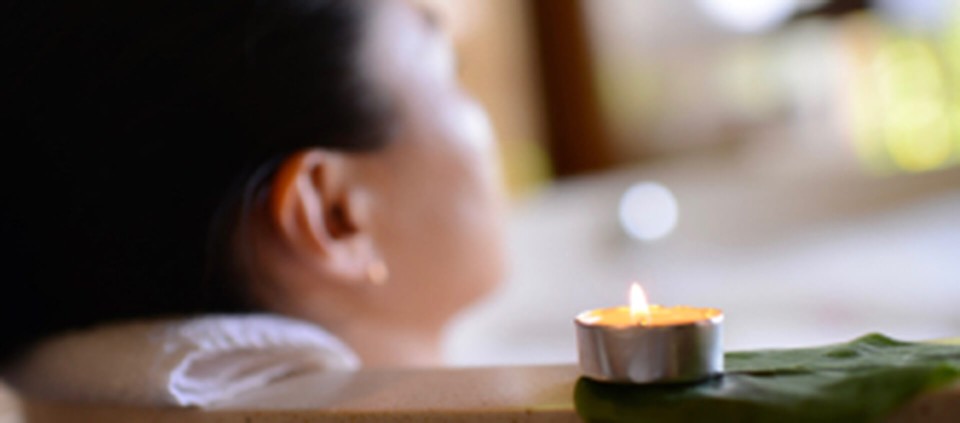Home Aromatherapy to Promote Calm and Better Sleep

March 17, 2020
Do you have essential oils or incense at home that have been collecting dust? Scented soy candles stashed on bookshelves? Bath salts or sugar scrubs buried in bathroom drawers? Time to put those aromas to good use!
During these challenging times, aromatherapy is a simple yet effective way to relieve stress, calm the mind, and enhance overall well-being from the comfort of home. Aromatherapy works mainly on the level of prana (life-force energy, vitality, or chi); it’s a subtle modality that can be wonderfully refreshing for depleted energy and exhausted minds.
For thousands of years, Ayurveda (yoga’s sister science) has used aromatherapy to maintain health, strengthen the immune system, promote healing, relax the nervous system, reduce pain, enhance mental clarity, and support meditation. As aromas are delicate and subtle, they penetrate the sense organs and the mind, enhancing the flow of prana throughout the entire body-mind. Powerful stuff!
Among the many potential benefits of aromatherapy, potent organic scents have been used to help clear negative emotions (e.g., worry, fear, confusion) while increasing positive motions (e.g. serenity, creativity, joy). Emotionally, aromas have the power to both calm and gladden the heart, while purifying the nadis (the subtle energy channels affecting the mind) and boosting sattva—clarity, harmony, and inner balance.
As an Ayurveda teacher for over a decade, I’ve found that simple aromatherapy practices keep me calm and centered during stressful times. If you’re feeling overwhelmed at the moment, try a few of these time-tested approaches to soothe the nerves, enhance mental clarity, and balance your energy.
Don’t have essential oils or incense on hand? Look around the house for products containing calming scents, such as candles, soaps, scrubs, bath gels, etc.—it’s likely you already have some of these aromas at home. Simply use them as instructed—perhaps a long, soothing bath with some deep breathing.
Essential Oil Techniques
Here are the most common ways to use essential oils:
- Candle Diffuser: easy to use and provides gentle background fragrance. This is my favorite method, as it is quite user-friendly, mild, and traditional. Wonderful to use while reading, journaling, or meditating. Be mindful of the open flame.
- Electric Diffuser: easy to use and can provide slightly stronger fragrance than candle diffuser
- Air Diffuser: vaporizes essential oils to spread a strong fragrance. Really nice to use during yoga practice or when wanting aromas to spread throughout the house. (Needs regular cleaning!)
- Massage: A long, slow self-massage (abhyanga) is a staple in the Ayurvedic self-care repertoire. Adding three to 10 drops of high-quality essential oil to 1 fluid ounce of base carrier oil (e.g., sesame, sunflower, or coconut) to boost massage benefits. Use fewer drops for stronger-scented essential oils and more drops for subtle scents.
Essential Oils: Safe Usage
To ensure that essential oils provide soothing relief, prioritize these safe practices:
- External use only: Avoidtaking essential oils internally, as they are potent enough to cause gastric hyperacidity if ingested—some essential oils can burn a whole in the lining of the stomach. Only use externally.
- Always dilute: Avoid putting essential oils directly onto the skin, as their concentrated state usually irritates the skin, senses, and the mind. It’s best to dilute essential oils in a carrier oil (like sesame or coconut oil) or water before applying to the skin.
- Ventilate: Ensure good air circulation and ventilation to avoid overexposure, which could lead to headache, irritability, or dizziness).
- Sealed: Keep essential oils safe in tightly closed containers and store in a cool, dark location (avoid sun and heat exposure).
- Avoid eye contact: the eyes and mucus membranes in the nose are too sensitive for direct exposure to essential oils and cause intense irritation.
- Sensitive skin care: Avoid contact of the skin with essential oils when challenged by skin rash, dermatitis, or eczema. Burning incense or using an air/candle diffuser would be a great option instead.
7 Aromas for Calming the Mind
To enhance inner peace, below are some of my aromatherapy favorites, along with their benefits and which dosha they're recommended for. If you don't know your dosha, take our quiz.
Sandalwood: Well known for soothing the mind and nourishing the heart, sandalwood’s sweet, pungent aroma is praised for reducing anxiety and irritability. This aromatic bark is commonly used to support meditation and boost inner peace. A sacred aroma for enhancing clarity and tranquility—perfect nowadays.
- Best usage: incense, diffuser, or diluted in massage oil
- Ayurvedic use: Tridoshic—great for vata, pitta,and kapha
Rose: With its sweet aroma and cooling nature, rose is wonderfully effective for refreshing the heart. Perfect when feeling agitated, overheated, stressed, lonely, or disappointed, it’s a nourishing, fragrant pick-me-up.
- Best usage: diffuser or diluted in massage oil—or place the fresh flower in a vase and smell the rose often
- Ayurvedic use: excellent for pitta dosha
Lavender: The go-to aroma for stress relief, this nourishing scent comes from an aromatic bush. Lavender’s sweet, cooling nature is praised for soothing the nerves, calming heightened emotions, and improving mood. It’s wonderful for settling the kids and preparing the household for a restful night’s sleep.
- Best usage: diffuser
- Ayurvedic use: tridoshic, but especially valuable for elevated vata dosha (e.g., stress, anxiety, nervousness, sleeplessness)
Lemon Balm: The sweet, cooling lemon balm leaves have long been used to calm and relax the nerves. Great when feeling frazzled or overwhelmed and a favorite of parents wanting to settle overly excited children, this aroma can help reduce stress and anxiety felt by the whole family. It’s also commonly used to support a good night’s sleep.
- Best usage: diffuser or diluted in massage oil
- Ayurvedic use: generally best for vata dosha
Frankincense: This precious tree resin is one of the most popular of all the aromatherapies. Used for thousands of years in countless cultures, frankincense is known for calming the mind, supporting prayer, boosting mood, and enhancing clarity. When used as a massage oil, it helps to relieve pain while keeping the body limber. Traditionally, this powerful, warming aroma has been used to support deep meditative states and enhance self-awareness.
- Best usage: incense or diluted in massage oil (this is one of the only essential oils gentle enough to put a drop into the palms, rub, and take a deep inhalation—a quick fix)
- Ayurvedic use: generally best for vata and kapha dosha
Lily: With its cooling effects, lily is a favorite aroma for soothing the nerves, harmonizing the emotions, and comforting the heart. It’s praised for reducing anxiety, soothing sleep disturbances, and easing dissatisfaction. Bonus: Lily is often used to nourish the lungs.
- Best usage: diffuser (or fresh flower in a vase)
- Ayurvedic use: generally best for pitta and vata dosha
Vetiver: This aromatic grass is cooling, refreshing, and deeply relaxing—commonly used for calming the mind and stabilizing the nervous system. A wonderful choice when feeling scattered, foggy-headed, depleted, or exhausted.
- Best usage: candle diffuser (vetiver is too sticky for electric and water diffusers) or diluted in massage oil (this is a very strong essential oil, so just a drop or two is enough)
- Ayurvedic use: generally best for pitta and vata dosha
Larissa Hall Carlson, E-RYT 500, MA, 20-year Kripalu faculy and former Dean of the Kripalu School of Ayurveda, guides retreats, directs trainings, and provides Ayurvedic consultations across the country.
Full Bio and Programs